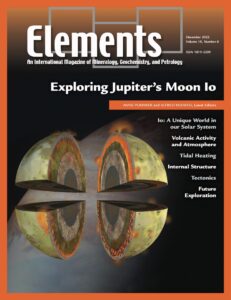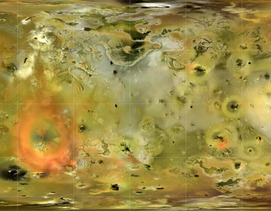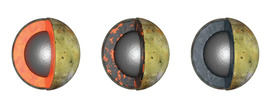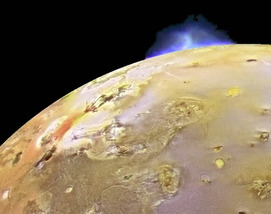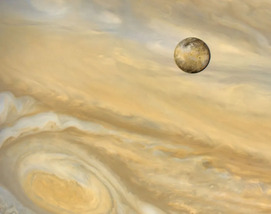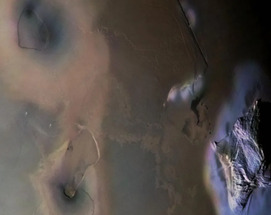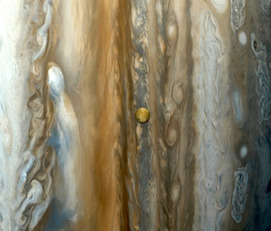Exploring Jupiter’s Moon Io
Annie Pommier and Alfred McEwen – Guest Editors
Table of Contents
Overview
Advertisers
Next Issue
2022 Topics
Overview
Jupiter’s moon Io is the best place to understand a fundamental planetary process that shaped terrestrial planets, icy ocean worlds, and extrasolar planets: tidal heating. Io is the most tidally heated world in our Solar System and may contain a magma ocean. Io’s spectacular volcanic plumes sustain the atmosphere and feed the giant magnetosphere of the Jovian system. The lavas covering its surface reflect heatpipe tectonics, which is analogous to the volcanically hyperactive youth of all rocky planets. Io is the ideal planetscale laboratory to study the intertwined processes of tidal forcing, extreme volcanism, and atmosphere–magnetosphere interactions. This issue of Elements will review our knowledge of Io, emphasizing on its composition, interior dynamics, and surface processes. We will also share perspectives for future missions.
- Io: A Unique World in our Solar System
- Tidal Heating in Io
- Io’s Volcanic Activity and Atmosphere
- The Internal Structure of Io
- The Cycles Driving Io’s Tectonics
- Perspective: The Future Exploration of Io
Advertisers
Next Issue
v19n1 Alkaline Lakes
GUEST EDITORS: Benjamin M. Tutolo (University of Calgary, Canada) and Nicholas J. Tosca (University of Cambridge, UK)
Alkaline lakes are incredibly dynamic, unique, and fascinating biogeochemical environments. This thematic issue will leverage the authors’ multidisciplinary insights to portray alkaline lakes’ biogeochemical, mineralogical, and geological importance for both science and society. The articles will individually explore the unique conditions leading to the formation of alkaline lakes, the distinctively productive microbial ecosystems that inhabit them, their distinguishing chemistry and mineralogy, their role as societally important economic resources, and their potential to have originated life on Earth as well as Mars. This approachable overview of the geochemical, biological, and societal aspects of alkaline lakes will establish their vital importance to the broad readership of Elements and stimulate continued explorations of these mesmerizing geological systems.
- Dry, Salty, and Habitable: The Science of Alkaline Lakes Benjamin M. Tutolo (University of Calgary, Canada) and Nicholas J. Tosca (University of Cambridge, UK)
- How to Make an Alkaline Lake: Fifty Years of Chemical Divides Nicholas J. Tosca (University of Cambridge, UK) and Benjamin M. Tutolo (University of Calgary, Canada)
- Making Salt from Water: The Unique Mineralogy of Alkaline Lakes Maija J. Raudsepp (University of Alberta, Canada), Siobhan A. Wilson (University of Alberta, Canada), and Bree Morgan (Sydney University, Australia)
- The Vigor, Vanity, and Application of Microbial Element Cycles in Alkaline Soda Lakes Marianne Haines (University of Calgary, Canada), Varada Khot (University of Calgary, Canada), and Marc Strous (University of Calgary, Canada)
- High Carbonate Alkalinity Lakes on Mars and their Potential Role in an Origin of Life Beyond Earth Joel A. Hurowitz (Stony Brook University, USA), David C. Catling (University of Washington, USA), and Woodward W. Fischer (Caltech, USA)
2022 Topics
- Halogens: From Planetary Surfaces to Interiors (February 2022)
- Organic Biomarkers (April 2022)
- Water in Planetary Bodies (June 2022)
- Cascadia Subduction Zone (August 2022)
- Cement and Concrete: From the Romans to Mars (October 2022)
- Exploring Jupiter’s Moon Io (December 2022)
Thematic Articles
Jupiter’s moon Io is the most volcanically active world in our Solar System. Eruptions on Io sustain its atmosphere, feed the Jovian magnetosphere, and contaminate neighboring moons. This unique volcanic and tectonic activity is powered by tidal heating, caused by its gravitational interactions with Jupiter and other moons. The silicate crust of Io is coated with sulfur compounds, and its interior—one that is exceptional for an outer-planet moon—is composed of a metallic core and a silicate mantle that may host a magma ocean. Such spectacular large-scale volcanism and high heat flow provide insights into the processes that shaped all terrestrial bodies. Future exploration of Io would answer key questions and herald a new era of discoveries about the evolution of terrestrial planets and moons within our Solar System and beyond.
Io experiences strong, periodic, gravitational tides from Jupiter because of its close distance to the planet and its elliptic orbit. This generates internal friction that heats the interior, a naturally occurring process in the Solar System and beyond. Io is unique in our Solar System because it gets most of its internal energy from this tidal heating, providing an ideal laboratory for improving our understanding of this fundamental process that plays a key role in the thermal and orbital evolution of the Moon, satellites in the outer Solar System, and extrasolar planets.
Driven by tidal heating, Io’s extreme volcanism has created a young, impact crater–free surface dominated by hundreds of active volcanic centres. From these volcanoes erupt voluminous, low-viscosity, high-temperature silicate lavas. Volcanic plumes, from venting gas and mobilised surface ices (primarily SO2 and S), contribute to Io’s thin atmosphere. Away from volcanoes, SO2 ice on the surface alternately sublimes during the daytime and condenses during eclipses and at night, resulting in a strong day/night atmospheric dichotomy. Sunlight and radiation bombardment at high altitude breaks the gas molecules apart, leading to the formation of SO, O, O2, S, K, Na, and Cl. These atoms reside as both neutral and charged particles in clouds that are found along Io’s orbit around Jupiter.
Io is a differentiated body with a silicate crust and mantle, and an iron-rich core. However, its internal structure, especially that of its mantle, differs from that of other terrestrial bodies, as a result of the intense heat supply by tidal dissipation. The amount and distribution of melt in Io’s interior strongly depend on the composition, as well as the heat and mass transport mecha- nisms operating at depth and in the near-surface. This article discusses melting processes and the mechanisms of magma segregation inside Io, informed by Earth-based observations and spacecraft measurements, as well as thermo- chemical and thermo-physical modeling.
Io is famous for its active volcanoes, but its vigorous tectonics, which are unlike Earth’s plate tectonics, are no less remarkable. The nature of Io’s thick, cold, brittle lithosphere has been revealed through decades of investigations. The dynamics of this system is most easily explained by considering three cycles: magmatic, tectonic, and sulfurous. The magmatic cycle trans- ports heat by a “heat pipe” process that may have operated during the earliest histories of many of the rocky bodies in the Solar System. The subsidence of the erupted lavas drives mountain uplift in the tectonic cycle. Sulfurous fluids could have a significant impact on the movement of both heat and rock.
Io is one of the best natural laboratories in the Solar System to study the intertwined processes of tidal heating, extreme volcanism, and atmospheric–magnetosphere–surface interactions. While substantial advances can be made with forthcoming ground- and space-based observatories, many outstanding questions can only be addressed with in situ measurements at Io. Several spacecraft will explore the Jupiter system in the next decade, but their capabilities to investigate Io are limited. A dedicated Io mission is neces- sary to capitalize on Io’s scientific potential. Previous Io mission concepts have spanned the gamut, including small spacecraft, multiple-flyby missions, orbiters, and landers. New technologies, including advanced solar power and radiation hardening, make Io exploration more tractable, and the potential for contemporaneous measurements from multiple spacecraft in the Jupiter system make a modern Io mission all the more compelling.



